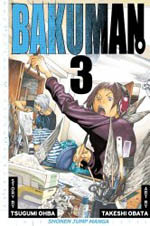 Written by Tsugumi Ohba
Written by Tsugumi Ohba
Art by Takeshi Obata
200 pages, black and white
Published by Viz
When I first started reading Tsugumi Ohba and Takeshi Obata’s Bakuman last year, I was almost instantly intrigued by the glimpse into the manga publishing world, and getting a look into the mechanics of pitching to and being published by the big leagues. Through the eyes of two high school students, Ohba and Obata looked to be making a fictionalized version of, "How the publishing industry works." As Bakuman has progressed, though, what we’re starting to get now is something even more interesting—most notably a question of what happens when you try and become more "commercial" in your comic-creating.
The problems that show up in Bakuman Vol. 3 for artist Moritaka and writer Akito are ones that aren’t contained in Japan’s manga scene, but rather ones that are worldwide, both in comics and other art forms. After their first story "The World is All About Money and Intelligence" only comes in third place, they decide the best way to get their own series is to go for something less unique and more familiar to the readers of Shonen Jump. Namely, "battle" manga, where plots are structured around fights between characters. It’s an intriguing twist, one that takes the book down a path I hadn’t expected. After all, the main characters are so driven at being the best manga creators they can be that it’s a little startling to see them decide to shelve their less-commercial ideas in favor of a genre they don’t find as interesting but more lucrative; doubly-so since this series is actually published in Shonen Jump in Japan.
Of course, it might have gone over with their publisher a little better when you consider that it’s their editor (Akira Hattori) whom is trying to steer them away from going for the quick buck and instead sticking true to their passion. Sure, it admits that there’s a certain system at play, but Bakuman also gives the publishing end of the equation a slightly polished and nourishing look in the form of Akira. Still, Bakuman doesn’t provide a simple, "This is right, this is wrong" path to being published. When we meet high school prodigy Eiji Nizuma, it’s during Moritaka’s time as Eiji’s assistant that Eiji starts to learn about the value of storyboarding his chapters ahead of time, and working more closely with his editor. It looks like a cautionary tale at first, especially since the "ratings" for the second chapter of Eiji’s new series have slipped… but even as all of this unfolds and Eiji vows to start working in this more controlled manner, the third chapter’s ratings show a large upswing. Eiji will no doubt ultimately benefit from the advice given, but Ohba still lets Eiji turn out to be succeeding with his unorthodox style as well.
As much as I’m loving the look behind the scenes (and having Moritaka act as an art assistant was a nice glimpse into that side of the manga industry which is often quietly ignored), the one thing in Bakuman that I’m finding increasingly problematic as the series progresses is the relationship between Moritaka and his girlfriend-from-afar Miho. I’d thought after reading the first volume that Miho would be more or less dropping out of the series, with Miho and Moritaka pledging to be together only once they’d both succeeded in their career goals. But with each new chapter, we’re getting two things. First, a continuing presence of Miho, as Moritaka continues to vacillate on if staying apart is really such a good thing. And second, the growing relationship between Akito and Miho’s best friend Kaya. Moritaka’s constant second-guessing of himself over staying apart from Miho is growing old, and while Miho gets to be the one to text-message the words of wisdom, her personality-thin presence makes her feel less like a real character and more like a token. I know these scenes are meant to help reinforce that their decision was a good one, but if anything it makes me feel like the pair aren’t terribly bright. And of course, Akito and Kaya being together really makes matters worse in this regard. They’re such a fun couple, and one where it’s clear that Akito’s work isn’t suffering (I love the scene where Kaya boxes with Akito to help him understand when writing battle manga what it’s actually like to be in a fight). Even when Moritaka wonders the same thing himself, the reasoning that shows up is less than satisfactory. It’s a story element I’d ultimately like to see jettisoned, even as I know we’re stuck with it.
Aside from this increasingly annoying relationship, though, Bakuman is still getting stronger with each chapter. The chapters in this volume about picking personally-interesting stories versus a quick cash grab are intriguing, and of course it helps that Obata’s work (just like in Hikaru no Go and Death Note) looks as handsome as ever. There are only a handful of manga translated into English that give such a thorough look behind the scenes (for a historical non-fiction perspective you should definitely check out A Drifting Life, and for a more modern and also uber-depressing take on the industry, Disappearance Diary), but even if there was a huge field available I’m convinced Bakuman would be one of the best. Ohba and Obata’s Bakuman is must-reading for anyone interested in the industry of comics.
Purchase Links: Amazon.com | Powell’s Books
